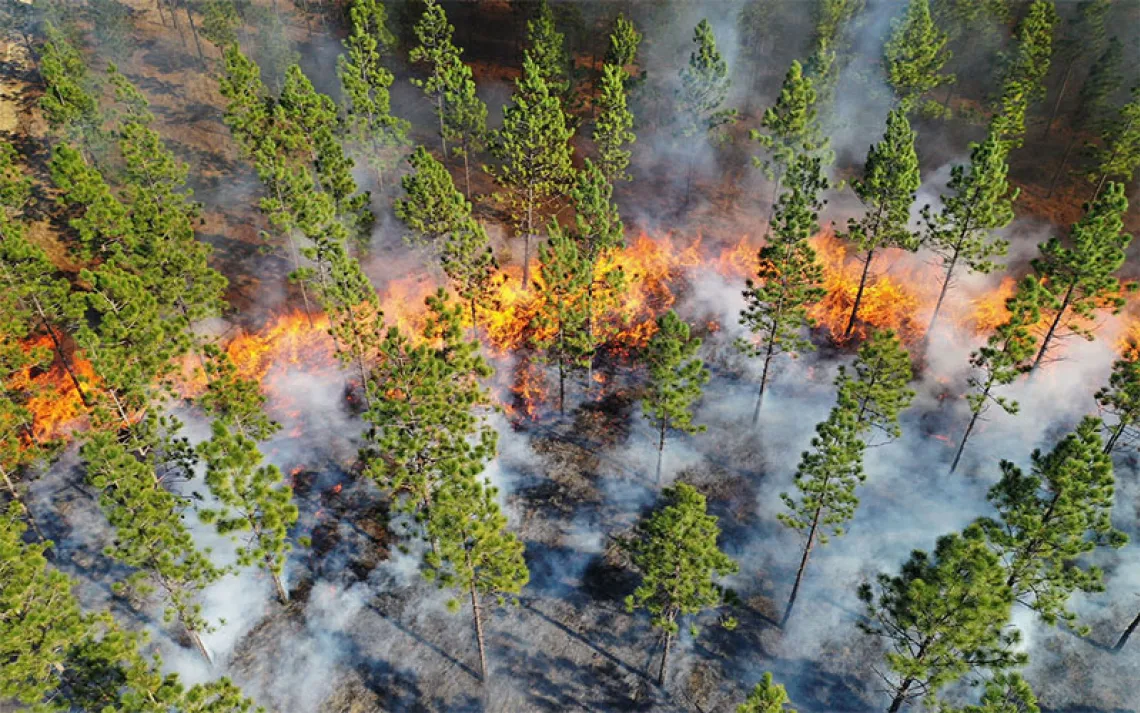Florida's Big Oil National Preserve
Just north of the Everglades, Big Cypress welcomes oil drilling

Everglades National Park itself isn't subject to oil drilling. But Big Cypress National Preserve, to the north, could see a major drilling expansion.
|Photographs by Ian Shive
Here's something you don't expect to see in a national park unit: a 30-ton "vibroseis" truck, outfitted with enormous balloon tires, dropping a huge steel plate to the ground. WHUMP! The plate, attached to the truck's underside, delivers an intense jolt, sending seismic waves deep into the earth to reveal hidden pockets of oil and natural gas.
Welcome to Big Cypress National Preserve—729,000 acres of cypress forests, pinelands, and wet prairies just north of Everglades National Park. It was established in 1974, when descendants of Barron Collier, an advertising magnate turned Florida land baron, sold half a million acres of their vast holdings to the federal government. There was a catch, however: The Collier family would retain oil and gas rights to the property.
Today, Big Cypress National Preserve has 10 active oil wells, all operated by Los Angeles-based Breitburn Energy Partners. That's about a third as many as were active in the preserve in the 1990s, and it's far fewer than the number of wells operating in some of the 11 other national park units where oil drilling is allowed. (As of 2013, Lake Meredith National Recreation Area in the Texas Panhandle had about 170 wells, and Big South Fork National River and Recreation Area, straddling the border between northern Tennessee and southern Kentucky, had about 150.) A major expansion of drilling at Big Cypress, however, could make its oil-well footprint the most extensive on national parkland in the United States.
Pad 2 at Big Cypress's Raccoon Point is six acres of hard-packed aggregate fill, as unnatural as an oil rig. Tens of thousands of gallons of oil-saltwater slurry—pumped from the 12,000-foot-deep Sunniland Formation—arrive here daily. Some slurry comes from five conventional suction wells on the site, more via flow lines that snake alongside one-lane gravel roads.
At 11 green silos, oil is heat-separated from the brine, then pumped into huge cylindrical storage tanks. Beyond them are the cypress trees for which the preserve is named as well as yellow and green saw palmettos and sawgrass prairie. Were it not for the industrial sprawl and brain-rattling drone of four locomotive-size diesel generators, you might glimpse a black bear or one of the threatened or endangered species—red-cockaded woodpeckers, snail kites, caracaras, wood storks, Florida panthers—that call Big Cypress home.

A young alligator in Everglades National Park.
The preserve's wells have mostly been confined to Raccoon Point and Bear Island, roughly 10 square miles total. "We have a stipulation that oil and gas cannot control more than 10 percent of Big Cypress," says Don Hargrove, the ranger in charge of oil operations. "We're not even near 1 percent." Now, however, the oil industry is trying to expand its gravelly footprint dramatically. Last summer, the Florida Department of Environmental Protection issued Fort Worth-based Burnett Oil Co. a permit to explore for oil across 70,400 acres—10 percent of the preserve's area—between Raccoon Point and Bear Island.
Conservationists are flabbergasted. "Why would you experiment with 70,000 acres?" asks Jennifer Hecker, director of natural resource policy at the Conservancy of Southwest Florida. Some fear that Burnett's explorations could lay the groundwork for even more extensive drilling. Nicholas Lund, senior manager for the National Parks Conservation Association's conservation programs, notes that Burnett is seeking to explore a far larger zone; the firm divided the area into four smaller sections in hopes of expediting approval. "Nothing on the scale of what is being proposed at Big Cypress—eventually possibly 360 square miles of drilling—is being done elsewhere," he says.
In May, despite threats of litigation by environmentalists, the National Park Service granted final approval for vibroseis machines to move through the preserve, concluding that the exploration "will not significantly affect the quality of the human environment." Burnett's operations are required to be 100 meters away from the nests of wading birds and 61 meters from those of red-cockaded woodpeckers. After complaints by conservationists, the Park Service did stipulate that before convoys of vibroseis trucks move through the park, contract ecologists must first give the all clear, declaring that no endangered gopher tortoise burrows or Florida bonneted bat roosts are in their path.
The Park Service also considered two alternative exploration scenarios: One involved the use of explosives, compared to which vibroseis technology seems gentle. The other was to send the plan back for revision—which Bob DeGross, Big Cypress's public affairs officer, says was not really an option. "That could invite a taking claim," he explains, referring to the Fifth Amendment, which prevents a governmental entity from taking private property without compensation.
Conservation groups agree—up to a point. "At the very least and as a no-brainer first step," Lund says, "the NPS must complete a full environmental impact study to ensure that they're doing their statutory obligation to protect park resources." The last study pertaining to oil operations in the preserve was conducted 24 years ago. Florida senator Bill Nelson and U.S. representative Alcee Hastings have added their political weight to the calls for a new EIS, which could take several years to complete.
But there's another major option that the NPS did not contemplate: a buyout. "It's certainly a reasonable alternative, if for no other reason than it's specifically mentioned in [the Park Service's] management plan," says Amy Mall, senior policy analyst for the Natural Resources Defense Council's Land and Wildlife Program. "If development is going to harm the resources in the preserve, then they have to consider a buyout as an option."
It might not cost that much. In 2003, the Bush administration tried to get Congress to pay Collier Resources Company $120 million for its rights, but the deal fell apart when Interior Department inspectors declared the valuation to be wildly high. Since then, of course, market conditions have changed. Tightening environmental standards combined with declining oil prices might make returning all of Big Cypress to the gopher tortoises and Florida panthers the best deal of all.
 The Magazine of The Sierra Club
The Magazine of The Sierra Club



